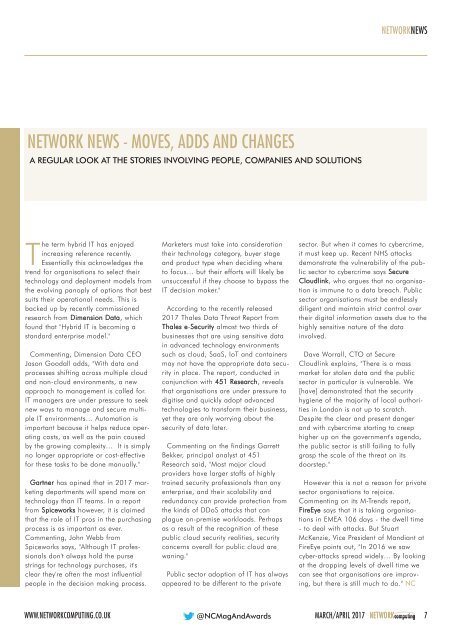NC1703
You also want an ePaper? Increase the reach of your titles
YUMPU automatically turns print PDFs into web optimized ePapers that Google loves.
NETWORKNEWS<br />
NETWORK NEWS - MOVES, ADDS AND CHANGES<br />
A REGULAR LOOK AT THE STORIES INVOLVING PEOPLE, COMPANIES AND SOLUTIONS<br />
The term hybrid IT has enjoyed<br />
increasing reference recently.<br />
Essentially this acknowledges the<br />
trend for organisations to select their<br />
technology and deployment models from<br />
the evolving panoply of options that best<br />
suits their operational needs. This is<br />
backed up by recently commissioned<br />
research from Dimension Data, which<br />
found that "Hybrid IT is becoming a<br />
standard enterprise model."<br />
Commenting, Dimension Data CEO<br />
Jason Goodall adds, "With data and<br />
processes shifting across multiple cloud<br />
and non-cloud environments, a new<br />
approach to management is called for.<br />
IT managers are under pressure to seek<br />
new ways to manage and secure multiple<br />
IT environments… Automation is<br />
important because it helps reduce operating<br />
costs, as well as the pain caused<br />
by the growing complexity… It is simply<br />
no longer appropriate or cost-effective<br />
for these tasks to be done manually."<br />
Gartner has opined that in 2017 marketing<br />
departments will spend more on<br />
technology than IT teams. In a report<br />
from Spiceworks however, it is claimed<br />
that the role of IT pros in the purchasing<br />
process is as important as ever.<br />
Commenting, John Webb from<br />
Spiceworks says, "Although IT professionals<br />
don't always hold the purse<br />
strings for technology purchases, it's<br />
clear they're often the most influential<br />
people in the decision making process.<br />
Marketers must take into consideration<br />
their technology category, buyer stage<br />
and product type when deciding where<br />
to focus… but their efforts will likely be<br />
unsuccessful if they choose to bypass the<br />
IT decision maker."<br />
According to the recently released<br />
2017 Thales Data Threat Report from<br />
Thales e-Security almost two thirds of<br />
businesses that are using sensitive data<br />
in advanced technology environments<br />
such as cloud, SaaS, IoT and containers<br />
may not have the appropriate data security<br />
in place. The report, conducted in<br />
conjunction with 451 Research, reveals<br />
that organisations are under pressure to<br />
digitise and quickly adopt advanced<br />
technologies to transform their business,<br />
yet they are only worrying about the<br />
security of data later.<br />
Commenting on the findings Garrett<br />
Bekker, principal analyst at 451<br />
Research said, "Most major cloud<br />
providers have larger staffs of highly<br />
trained security professionals than any<br />
enterprise, and their scalability and<br />
redundancy can provide protection from<br />
the kinds of DDoS attacks that can<br />
plague on-premise workloads. Perhaps<br />
as a result of the recognition of these<br />
public cloud security realities, security<br />
concerns overall for public cloud are<br />
waning."<br />
Public sector adoption of IT has always<br />
appeared to be different to the private<br />
sector. But when it comes to cybercrime,<br />
it must keep up. Recent NHS attacks<br />
demonstrate the vulnerability of the public<br />
sector to cybercrime says Secure<br />
Cloudlink, who argues that no organisation<br />
is immune to a data breach. Public<br />
sector organisations must be endlessly<br />
diligent and maintain strict control over<br />
their digital information assets due to the<br />
highly sensitive nature of the data<br />
involved.<br />
Dave Worrall, CTO at Secure<br />
Cloudlink explains, "There is a mass<br />
market for stolen data and the public<br />
sector in particular is vulnerable. We<br />
[have] demonstrated that the security<br />
hygiene of the majority of local authorities<br />
in London is not up to scratch.<br />
Despite the clear and present danger<br />
and with cybercrime starting to creep<br />
higher up on the government's agenda,<br />
the public sector is still failing to fully<br />
grasp the scale of the threat on its<br />
doorstep."<br />
However this is not a reason for private<br />
sector organisations to rejoice.<br />
Commenting on its M-Trends report,<br />
FireEye says that it is taking organisations<br />
in EMEA 106 days - the dwell time<br />
- to deal with attacks. But Stuart<br />
McKenzie, Vice President of Mandiant at<br />
FireEye points out, "In 2016 we saw<br />
cyber-attacks spread widely… By looking<br />
at the dropping levels of dwell time we<br />
can see that organisations are improving,<br />
but there is still much to do." NC<br />
WWW.NETWORKCOMPUTING.CO.UK @NCMagAndAwards<br />
MARCH/APRIL 2017 NETWORKcomputing 7

















